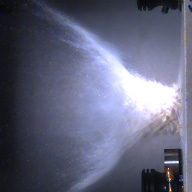
The Earth, like other planets and moons, is exposed to the risk of impacts by celestial bodies, e.g., asteroids that are on a collision course and may hit the Earth’s surface. Because of the involved great masses and extremely high collision velocities, such an event can have enormous destructive power.
In order to prevent a collision, the approaching asteroid could timely be redirected to a slightly different orbit by the impact of a spacecraft which functions as a kinetic impactor. The hypervelocity-impact laboratories of Fraunhofer EMI are experimentally investigating the achievable change in momentum for asteroids based on their structure and composition. On the basis of these results, such a protective measure can be designed.
A promising method for the deflection of celestial bodies from a collision course with Earth is the transfer of momentum through a kinetic impactor. A spacecraft, designed as a kinetic impactor, possesses a momentum determined by its mass m and speed v. However, at hypervelocity impact, the momentum transfer will be larger: Beside the spacecraft’s momentum, additional momentum transfer is achieved through ejection of material from the celestial body’s surface in opposite direction to the impact direction. This ejected mass creates a recoil (upper figure), which contributes an additional component to the momentum. This component can be strikingly larger than the pure momentum transfer created by the impactor, especially when the impacted material is brittle rock. This effect is called momentum enhancement.
Laboratory tests at Fraunhofer EMI further examine this effect on a small scale, where a spacecraft functioning as a kinetic impactor hits an asteroid-like surface. Here, the spacecraft is represented by a compact “projectile” made from aluminum. In the laboratory tests, different materials with asteroid-like properties, consisting, for example, of dense quartzite, porous sandstone or highly porous cellular concrete, are placed on a ballistic pendulum to measure the momentum transfer and are impacted with millimeter-sized aluminum projectiles. With porosities between 3 percent and about 90 percent, the selected rocks should cover a wide spectrum of asteroid-like materials and their behavior under impact conditions. Impact velocities of up to 9.5 kilometers per second can be reached with the Space Gun, one of the fastest gun accelerators for millimeter-sized projectiles worldwide, at Fraunhofer EMI.
Such high impact velocities are required to come close to the targeted collision svelocity in case of a real kinetic impactor mission. For the quantitative measurement of the momentum transfer, the swing of the pendulum is being recorded with the help of high-speed video cameras and laser interferometers. The first impact tests with velocities of up to seven kilometers per second recorded a momentum enhancement of up to a factor of four. It was also observed that the higher the porosity of the asteroids was, the lower the momentum enhancement. Furthermore, the results show that the momentum enhancement factor typically increases as a function of velocity except for the highly porous cellular concrete. Regarding this material, it was observed that from a limited velocity onwards, a further increase in impact velocity did not lead to further increase in the momentum enhancement factor. These initial findings are currently being refined and thoroughly analyzed.
Based on the experimental evidence, the effect of momentum transfer should be especially efficient for dense, heavy celestial bodies. Due to the large mass differences between an asteroid and an artificial kinetic impactor, asteroids can only be deflected by a few centimeters per second at most from their original orbits. This must happen early enough to deflect the asteroid’s orbit significantly to avoid collision with Earth. The big challenge here is that a large part of asteroids consists of piles of rocks, so-called rubble piles, which are loosely held together by their weak gravitational force. In contrast to a compact solid, it is expected that rubble piles are dispersed through an impact, and due to that, the momentum transfer mechanism is less efficient as for a solid and needs to be described in a completely different way. To this purpose, respective tests are currently planned.
The scientific research regarding momentum transfer is part of the project “NEOShield – Preparing to Protect the Planet”, which is funded by the EU in the Seventh Framework Programme and is being coordinated by Prof. Dr. Alan Harris from the DLR Institute of Planetary Research. Here, scientists from Germany, France, Great Britain, Ireland, Spain, the US, Russia and Switzerland are working on solutions which can save the Earth from Earth-crossing asteroids, in cooperation with European aerospace corporations. Until mid-2015, a satellite mission to deflect asteroids via a kinetic impactor will be designed which is based on the impact research performed at Fraunhofer EMI.